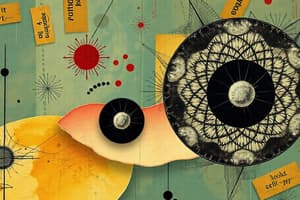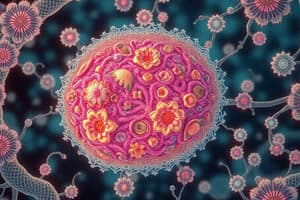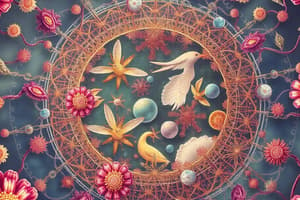Podcast
Questions and Answers
What is the primary function of the cell nucleus?
What is the primary function of the cell nucleus?
- Regulation of transport across the membrane
- Energy production
- Storage of genetic material (correct)
- Synthesis of proteins
Which organelle is primarily involved in energy production within the cell?
Which organelle is primarily involved in energy production within the cell?
- Ribosome
- Golgi apparatus
- Mitochondrion (correct)
- Lysosome
Which statement correctly describes the function of the plasma membrane?
Which statement correctly describes the function of the plasma membrane?
- It exclusively allows all substances to pass freely.
- It regulates transport and maintains cellular homeostasis. (correct)
- It synthesizes cellular proteins.
- It is solely involved in cell division.
What is a key characteristic of eukaryotic cell division?
What is a key characteristic of eukaryotic cell division?
Which component of the cell is primarily responsible for protein synthesis?
Which component of the cell is primarily responsible for protein synthesis?
What is the main distinguishing feature of eukaryotic cells compared to prokaryotic cells?
What is the main distinguishing feature of eukaryotic cells compared to prokaryotic cells?
What role do membrane-associated proteins play in the cell membrane?
What role do membrane-associated proteins play in the cell membrane?
Which of the following correctly defines the cytoplasm of a eukaryotic cell?
Which of the following correctly defines the cytoplasm of a eukaryotic cell?
What is true about viruses in relation to living organisms?
What is true about viruses in relation to living organisms?
Which of the following describes the main function of the cell membrane?
Which of the following describes the main function of the cell membrane?
What is found within the cytosol of eukaryotic cells?
What is found within the cytosol of eukaryotic cells?
Which structure is NOT found in prokaryotic cells?
Which structure is NOT found in prokaryotic cells?
What is one of the functions of lysosomes in eukaryotic cells?
What is one of the functions of lysosomes in eukaryotic cells?
What is the main function of the Rough Endoplasmic Reticulum (rER)?
What is the main function of the Rough Endoplasmic Reticulum (rER)?
Which of the following statements about the Smooth Endoplasmic Reticulum (sER) is true?
Which of the following statements about the Smooth Endoplasmic Reticulum (sER) is true?
How are proteins delivered to the Golgi body from the Rough Endoplasmic Reticulum?
How are proteins delivered to the Golgi body from the Rough Endoplasmic Reticulum?
Which structure is primarily responsible for processing and packaging proteins?
Which structure is primarily responsible for processing and packaging proteins?
What occurs to processed proteins after they leave the Golgi complex?
What occurs to processed proteins after they leave the Golgi complex?
Which of the following describes the structure of the Golgi body?
Which of the following describes the structure of the Golgi body?
The Smooth Endoplasmic Reticulum lacks what feature?
The Smooth Endoplasmic Reticulum lacks what feature?
What is a primary function of the Golgi body in relation to proteins?
What is a primary function of the Golgi body in relation to proteins?
What is one of the primary functions of the cytoskeleton in cells?
What is one of the primary functions of the cytoskeleton in cells?
Which class of cytoskeletal proteins is NOT responsible for positioning the nucleus?
Which class of cytoskeletal proteins is NOT responsible for positioning the nucleus?
What is the primary function of ribosomes within a cell?
What is the primary function of ribosomes within a cell?
What distinguishes fixed ribosomes from free ribosomes?
What distinguishes fixed ribosomes from free ribosomes?
Which cytoskeletal component is primarily involved in transport and mitosis?
Which cytoskeletal component is primarily involved in transport and mitosis?
What role do actin microfilaments play in a cell?
What role do actin microfilaments play in a cell?
Which statement about free ribosomes is accurate?
Which statement about free ribosomes is accurate?
What is the main composition of ribosomes?
What is the main composition of ribosomes?
What is the primary function of mitochondria?
What is the primary function of mitochondria?
Which cellular process is not typically associated with mitochondria?
Which cellular process is not typically associated with mitochondria?
What characteristic is NOT seen in mitochondria?
What characteristic is NOT seen in mitochondria?
What do lysosomes primarily contain?
What do lysosomes primarily contain?
Which function is not associated with lysosomes?
Which function is not associated with lysosomes?
How do lysosomes contribute to cellular health?
How do lysosomes contribute to cellular health?
What type of compounds do lysosomes digest?
What type of compounds do lysosomes digest?
Which process is directly facilitated by mitochondria?
Which process is directly facilitated by mitochondria?
What structure is responsible for packaging DNA into nucleosomes?
What structure is responsible for packaging DNA into nucleosomes?
Which process is essential for ensuring that genetic information is accurately passed to daughter cells?
Which process is essential for ensuring that genetic information is accurately passed to daughter cells?
What role do cyclin dependent kinases (CDKs) play in cellular functions?
What role do cyclin dependent kinases (CDKs) play in cellular functions?
What is a consequence of dysregulation of growth in cells?
What is a consequence of dysregulation of growth in cells?
What is the main purpose of the cell cycle?
What is the main purpose of the cell cycle?
How does chromatin form from DNA?
How does chromatin form from DNA?
What factor can trigger cell division in an organism?
What factor can trigger cell division in an organism?
What is the structure that carries genetic information within a cell?
What is the structure that carries genetic information within a cell?
What stages are interphase during the cell cycle?
What stages are interphase during the cell cycle?
Flashcards
Cell Structure
Cell Structure
The major components of a cell, including the cytoplasm, organelles, and nucleus.
Cytoplasm and Organelles
Cytoplasm and Organelles
The region inside the cell membrane, excluding the nucleus, that contains various organelles with specific functions.
Cell Nucleus
Cell Nucleus
The control center of the cell, containing the genetic material (DNA).
Eukaryotic Cell Division
Eukaryotic Cell Division
Signup and view all the flashcards
Plasma Membrane
Plasma Membrane
Signup and view all the flashcards
Prokaryotic cells
Prokaryotic cells
Signup and view all the flashcards
Eukaryotic cells
Eukaryotic cells
Signup and view all the flashcards
Cell membrane
Cell membrane
Signup and view all the flashcards
Cytoplasm
Cytoplasm
Signup and view all the flashcards
Cytosol
Cytosol
Signup and view all the flashcards
Mitochondria
Mitochondria
Signup and view all the flashcards
Nucleus
Nucleus
Signup and view all the flashcards
Viruses
Viruses
Signup and view all the flashcards
Cytoskeleton
Cytoskeleton
Signup and view all the flashcards
Actin Microfilaments
Actin Microfilaments
Signup and view all the flashcards
Microtubules
Microtubules
Signup and view all the flashcards
Intermediate Filaments
Intermediate Filaments
Signup and view all the flashcards
Ribosomes
Ribosomes
Signup and view all the flashcards
Free Ribosomes
Free Ribosomes
Signup and view all the flashcards
Fixed Ribosomes
Fixed Ribosomes
Signup and view all the flashcards
Rough Endoplasmic Reticulum (rER)
Rough Endoplasmic Reticulum (rER)
Signup and view all the flashcards
Rough ER
Rough ER
Signup and view all the flashcards
Smooth ER
Smooth ER
Signup and view all the flashcards
Golgi Body Structure
Golgi Body Structure
Signup and view all the flashcards
Golgi Body Function
Golgi Body Function
Signup and view all the flashcards
What does rER produce?
What does rER produce?
Signup and view all the flashcards
What does sER synthesize?
What does sER synthesize?
Signup and view all the flashcards
What is the role of transport vesicles?
What is the role of transport vesicles?
Signup and view all the flashcards
What is the function of secretory vesicles?
What is the function of secretory vesicles?
Signup and view all the flashcards
Mitochondria: Shape
Mitochondria: Shape
Signup and view all the flashcards
Mitochondrial Genome
Mitochondrial Genome
Signup and view all the flashcards
Mitochondria's Main Job
Mitochondria's Main Job
Signup and view all the flashcards
Mitochondria: Other Roles
Mitochondria: Other Roles
Signup and view all the flashcards
Lysosomes: Function
Lysosomes: Function
Signup and view all the flashcards
Lysosome Contents
Lysosome Contents
Signup and view all the flashcards
Lysosome Origin
Lysosome Origin
Signup and view all the flashcards
Lysosomes: Endocytosis/Phagocytosis
Lysosomes: Endocytosis/Phagocytosis
Signup and view all the flashcards
Nucleus Function
Nucleus Function
Signup and view all the flashcards
Nucleolus Function
Nucleolus Function
Signup and view all the flashcards
DNA Condensation
DNA Condensation
Signup and view all the flashcards
Cell Division Purpose
Cell Division Purpose
Signup and view all the flashcards
Cell Division Requirement
Cell Division Requirement
Signup and view all the flashcards
Cell Cycle Regulation
Cell Cycle Regulation
Signup and view all the flashcards
Dysregulated Growth
Dysregulated Growth
Signup and view all the flashcards
What is this process?
What is this process?
Signup and view all the flashcards
Study Notes
Cell Biology Review 1
- Learning Objectives:
- Describe the major structural components of the cell
- Outline the structure and function of the cytoplasm and its organelles
- Explain the structure and function of the cell nucleus
- Outline the process of eukaryotic cell division and its regulation
- Describe the structure and function of the plasma membrane including how transport across the membrane is regulated
- Outline the structural-functional relationships of different cell types
What are Cells?
- Structural and functional units of all living things
- Prokaryotic cells (bacteria): simple
- Eukaryotic cells (animal and plant cells): larger, more complex, have a nucleus and membrane-bound organelles
- Viruses are not cells, not living organisms
Eukaryotic Cell Overview
- Cell membrane (plasma membrane): outer boundary
- Cytoskeleton: gives shape, support, and movement
- Mitochondria: produce ATP (energy)
- Lysosomes: contain enzymes for digestion
- Cytoplasm: all the material inside the cell membrane, excluding the nucleus
- Cytosol: fluid portion of the cytoplasm
- Golgi Body : modifies, sorts, and packages proteins
- Rough Endoplasmic Reticulum (RER): protein synthesis
- Smooth Endoplasmic Reticulum (SER): lipid synthesis, detoxification
- Ribosomes: protein synthesis
- Nucleus: controls cell activities, contains DNA
- Nucleolus: site of ribosome assembly
- Chromatin: DNA-protein complex
Functions of Cellular Structures
- Cell Membrane: Fluid phospholipid bilayer, barrier and regulates transport
- Cytoplasm and Cytosol: Cytoplasm is everything inside. Cytosol is the fluid portion with dissolved ions and macromolecules.
- Cytoskeleton: Gives shape, maintains polarity, organizes organelles
- Ribosomes: Synthesize proteins
- Free ribosomes are in the cytosol.
- Endoplasmic Reticulum (ER):
- Rough ER: protein synthesis, ribosomes attached.
- Smooth ER: lipid, steroid, and some carbohydrate synthesis; detoxification.
- Golgi Body: Processes, packages, and delivers proteins.
- Mitochondria: Produces ATP via oxidative phosphorylation
- Lysosomes: Digest waste and foreign materials
- Nucleus and Nucleolus: Nucleus controls cell activities, contains DNA. Nucleolus assembles ribosomes.
- DNA: DNA in chromosomes is wrapped, around histone proteins, becoming nucleosomes, which pack to form chromatin fibers. This condensation makes the DNA much more compact.
- Cell Cycle: Cells divide to grow and repair. Cells only divide when genetic material (DNA) has been accurately duplicated. The genetic material is equally distributed between two daughter cells.
Summary of Cell Cycle
- Cell cycle is regulated; CDKs regulate cell growth and division. Dysregulation leads to uncontrolled proliferation and cancer.
Studying That Suits You
Use AI to generate personalized quizzes and flashcards to suit your learning preferences.




